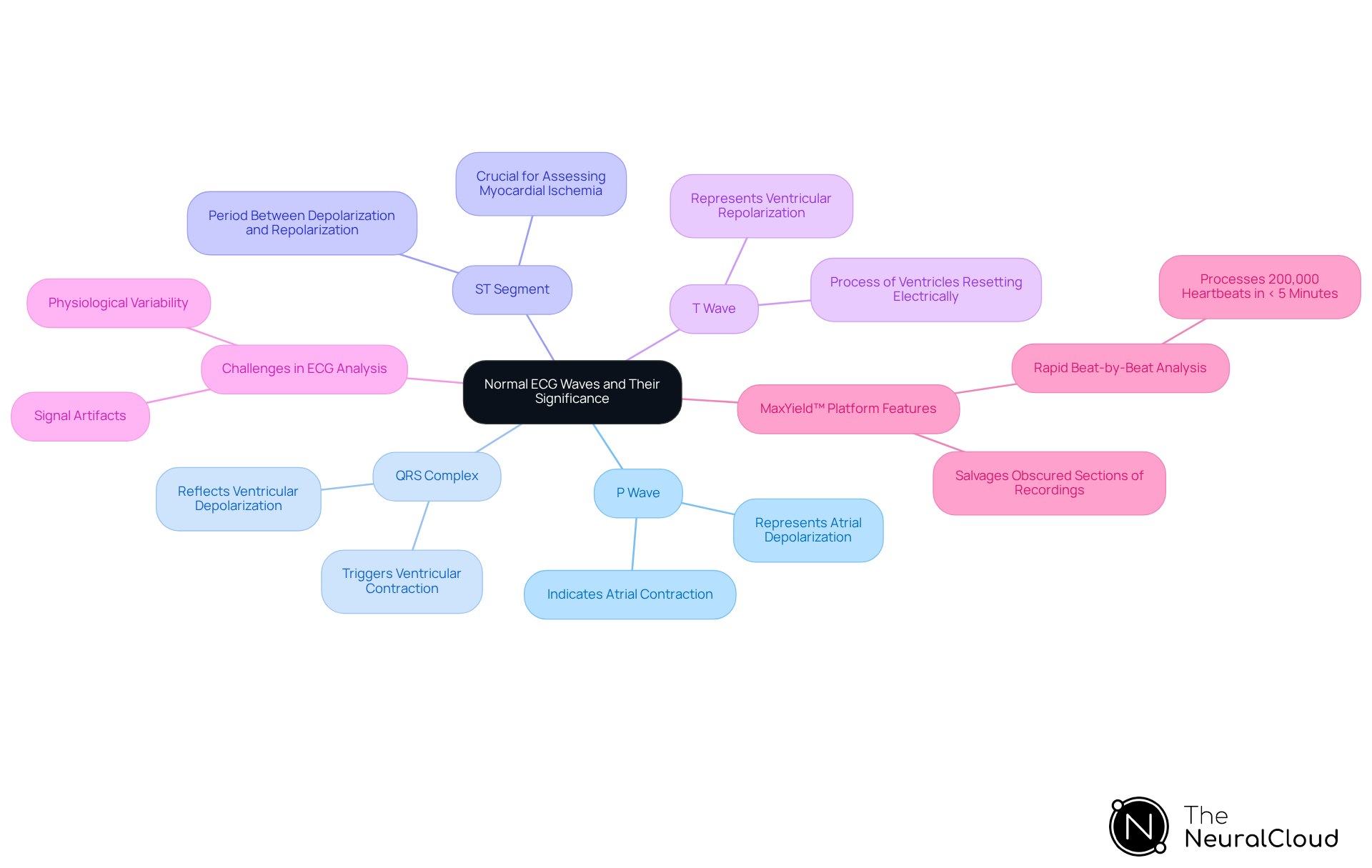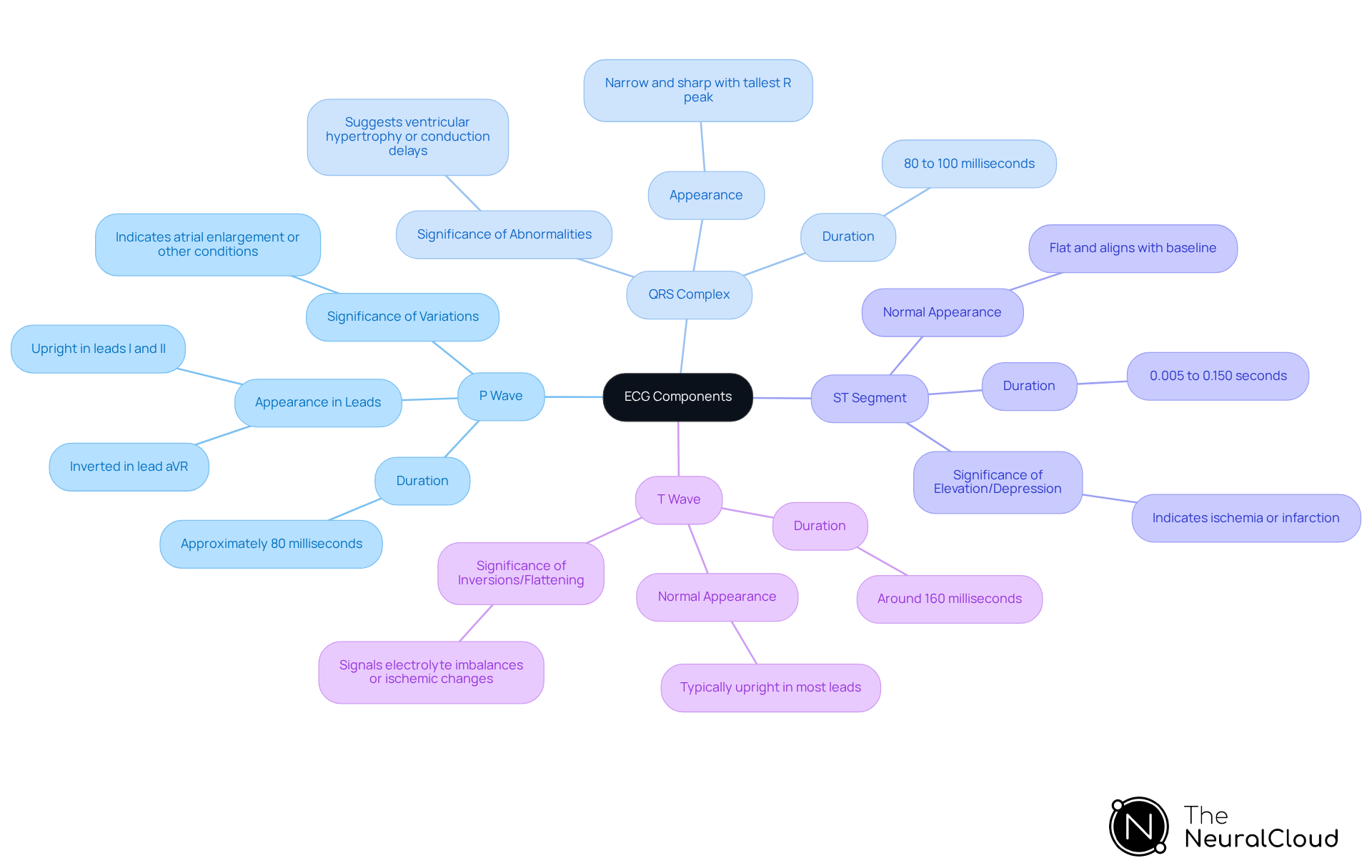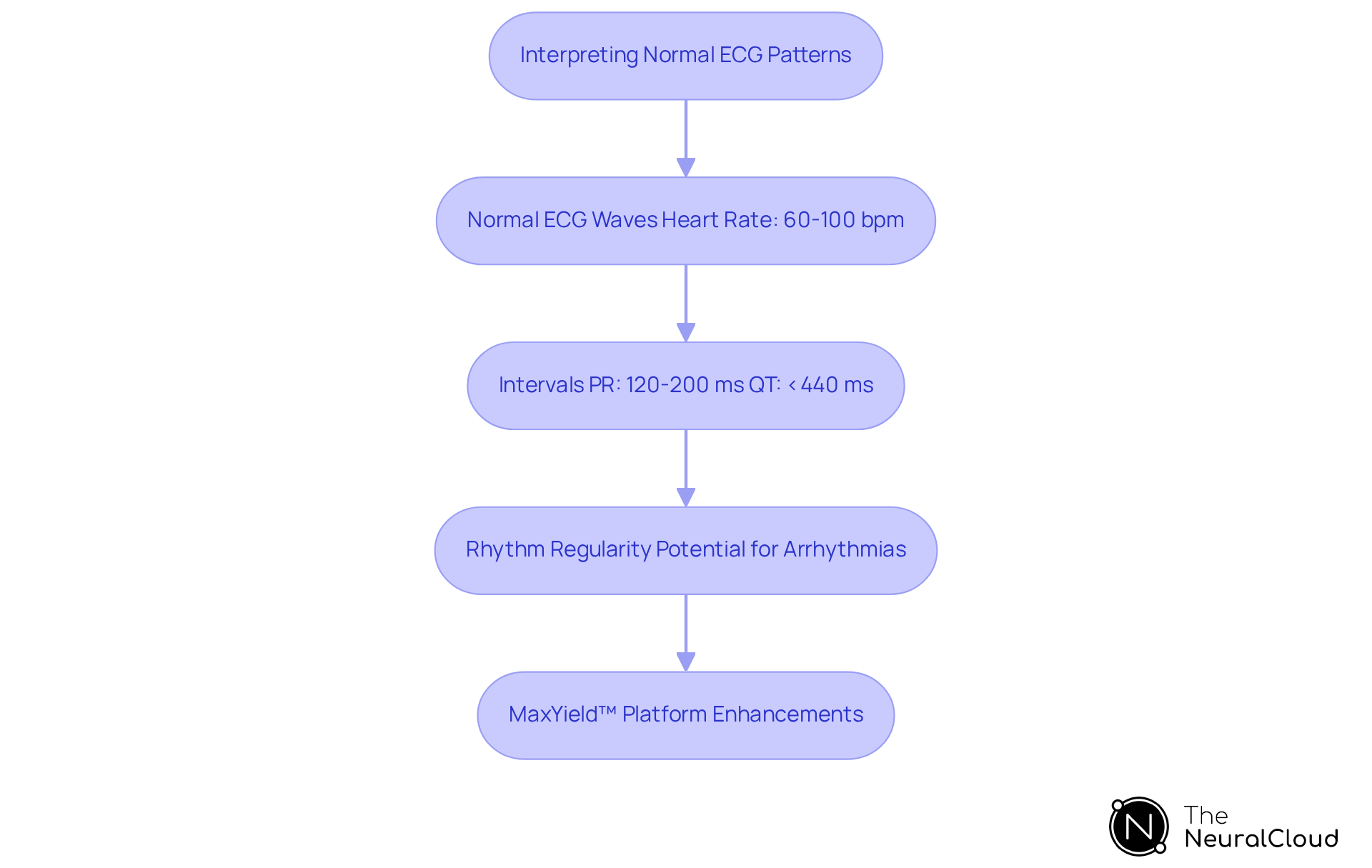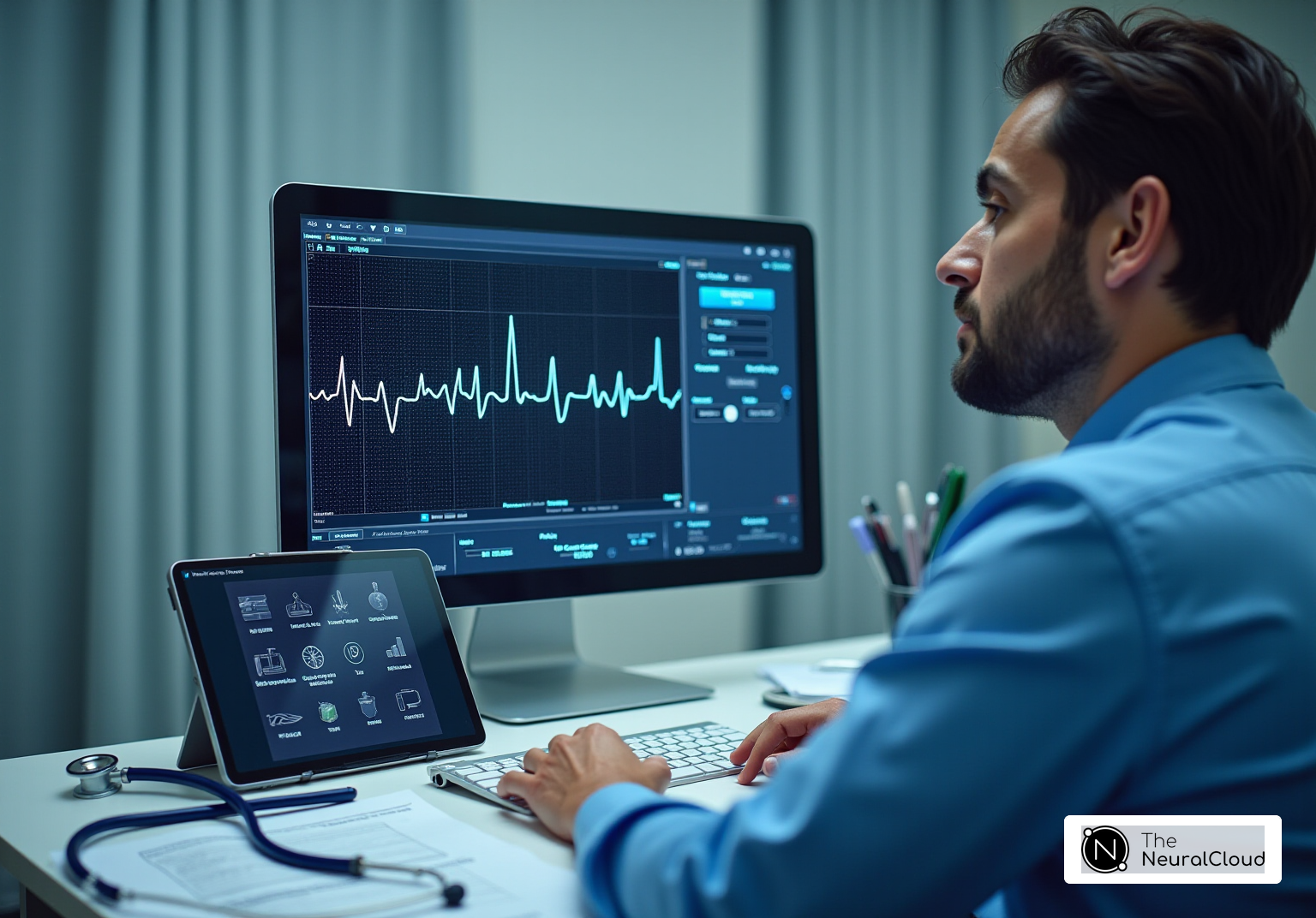Overview
The article emphasizes the importance of normal ECG waves and their components for health tech developers, highlighting how a comprehensive understanding of these elements can significantly improve diagnostic accuracy. It begins by addressing the common challenges encountered in ECG analysis, such as noise and signal artifacts, which can hinder reliable clinical assessments.
Central to this discussion is the MaxYield™ platform, designed to tackle these challenges effectively. The platform features advanced algorithms that filter out noise and enhance signal quality, ensuring more accurate readings. This capability not only streamlines the ECG analysis process but also increases the reliability of the results.
The advantages of utilizing the MaxYield™ platform extend directly to healthcare professionals, as it enhances their ability to make informed decisions based on clearer data. By improving diagnostic accuracy, the platform ultimately contributes to better patient care outcomes, fostering a more efficient healthcare environment. The integration of such technology represents a significant leap forward in the field of health tech, aligning with the needs of modern clinical practices.
Introduction
Normal ECG waves represent the electrical signature of the heartbeat, playing a vital role in understanding cardiac health and advancing health technologies. By comprehending the significance of each component—the P wave, QRS complex, ST segment, and T wave—developers can create algorithms that improve ECG analysis and diagnostics.
However, a significant challenge persists: how can developers effectively interpret these intricate signals amidst physiological variations and noise? This article explores the complexities of normal ECG waves, providing essential insights that enable developers to enhance patient outcomes through improved diagnostic tools.
Define Normal ECG Waves and Their Significance
Normal ECG waves represent the electrical activity of the heart during each heartbeat. The primary components consist of the P wave, QRS complex, ST segment, and T wave, each corresponding to specific electrical events in the heart:
- P Wave: Represents atrial depolarization, indicating the contraction of the atria.
- QRS Complex: Reflects ventricular depolarization, which is the electrical impulse that triggers the ventricles to contract.
- ST Segment: Indicates the period between ventricular depolarization and repolarization, crucial for assessing myocardial ischemia.
- T Wave: Represents ventricular repolarization, the process of the ventricles resetting electrically after contraction.
Understanding these elements is essential for , as it guides the formulation of algorithms that can precisely assess and decode ECG data. However, challenges in ECG analysis, such as physiological variability and signal artifacts, can hinder accurate interpretation.
The MaxYield™ platform addresses these challenges by incorporating advanced noise filtering and signal recognition. Key features of the platform include:
- Rapid beat-by-beat analysis, processing 200,000 heartbeats in less than 5 minutes.
- The ability to salvage previously obscured sections of recordings.
These features enhance diagnostic capabilities, ultimately leading to more efficient and reliable clinical decision-making for healthcare professionals. By utilizing Neural Cloud Solutions' platform, developers can significantly improve the accuracy of ECG analysis, ensuring that critical insights are readily available for patient care.

Analyze Key Components: P-Wave, QRS Complex, ST Segment, and T-Wave
Each component of the ECG possesses distinct characteristics that are crucial for accurate interpretation.
- P Wave: This wave is typically small and rounded, lasting about 80 milliseconds. It should appear upright in leads I and II, while being inverted in lead aVR. Variations in the P wave can indicate or other conditions.
- QRS Complex: The QRS complex lasts between 80 to 100 milliseconds. It should be narrow and sharp, with the R peak being the tallest. Abnormalities in this complex can suggest ventricular hypertrophy or conduction delays.
- ST Segment: Normally flat, the ST segment should align with the baseline level. Elevation or depression may indicate ischemia or infarction, with a duration typically ranging from 0.005 to 0.150 seconds.
- T Wave: Typically upright in most leads, the T wave lasts around 160 milliseconds. Inversions or flattening of the T wave can signal electrolyte imbalances or ischemic changes.
By analyzing these components, developers can enhance their understanding of normal ECG waves compared to abnormal ECG patterns, which is vital for creating effective diagnostic algorithms.

Interpret Normal ECG Patterns in Clinical Practice
In clinical practice, interpreting normal ECG waves involves recognizing typical configurations of waves and intervals. This process can be significantly enhanced by utilizing Neural Cloud Solutions' MaxYield™ platform.
Normal ECG waves are characterized by a heart rate of 60-100 beats per minute in a normal sinus rhythm, with each P wave followed by a QRS complex, indicating a healthy electrical conduction system. The MaxYield™ platform aids in accurately identifying these patterns, even amidst high levels of noise and artifact, ensuring reliable assessments.
Intervals: The PR interval should range from 120 to 200 milliseconds, while the QT interval should be less than 440 milliseconds. Deviations from these norms can indicate various cardiac conditions related to normal ECG waves. With this technology, creators can recover previously hidden parts of extensive Holter, 1-Lead, and patch monitor recordings, maintaining essential information that could otherwise be lost.
Rhythm Regularity: The rhythm should be regular, with consistent intervals between beats. Irregularities may suggest arrhythmias or other cardiac issues. Traditional ECG interpretation technology often struggles with large amounts of , but the MaxYield™ system evolves with each use, continuously enhancing diagnostic yield and accuracy over time.
By mastering the interpretation of these patterns and leveraging the capabilities of MaxYield™, health tech developers can ensure that their diagnostic tools provide accurate assessments. This ultimately improves patient outcomes and enhances clinical efficiency.

Conclusion
Mastering the intricacies of normal ECG waves is essential for health tech developers aiming to create effective diagnostic tools. These waves not only reflect the heart's electrical activity but also serve as a foundation for understanding cardiac health. By comprehensively grasping the components of ECG—namely the P wave, QRS complex, ST segment, and T wave—developers can significantly enhance the accuracy of their analysis and improve patient outcomes.
The article has explored the critical characteristics of each ECG component, emphasizing their unique roles in heart function and the potential implications of abnormalities. It also highlighted the advantages of the MaxYield™ platform, which addresses common challenges in ECG interpretation through advanced noise filtering and rapid analysis capabilities. The platform's features, such as superior signal clarity and swift processing times, enable healthcare professionals to extract vital insights effectively. By leveraging this technology, developers can ensure that crucial information is not lost, thereby fostering more reliable clinical decision-making.
In conclusion, the significance of normal ECG waves extends beyond mere data points; they are vital indicators of cardiac health that can guide health tech innovations. As the field of cardiology continues to evolve, embracing these insights and technologies will empower developers to contribute to more precise and efficient patient care solutions. The responsibility lies in harnessing this knowledge to enhance diagnostic accuracy and ultimately improve the quality of life for patients worldwide.
Frequently Asked Questions
What do normal ECG waves represent?
Normal ECG waves represent the electrical activity of the heart during each heartbeat.
What are the primary components of a normal ECG?
The primary components of a normal ECG include the P wave, QRS complex, ST segment, and T wave.
What does the P wave indicate?
The P wave represents atrial depolarization, indicating the contraction of the atria.
What is the significance of the QRS complex?
The QRS complex reflects ventricular depolarization, which is the electrical impulse that triggers the ventricles to contract.
What does the ST segment represent?
The ST segment indicates the period between ventricular depolarization and repolarization, which is crucial for assessing myocardial ischemia.
What does the T wave signify?
The T wave represents ventricular repolarization, the process of the ventricles resetting electrically after contraction.
Why is understanding ECG components important for health technology creators?
Understanding these elements is essential for health technology creators as it guides the formulation of algorithms that can precisely assess and decode ECG data.
What challenges exist in ECG analysis?
Challenges in ECG analysis include physiological variability and signal artifacts, which can hinder accurate interpretation.
How does the MaxYield™ platform address ECG analysis challenges?
The MaxYield™ platform addresses these challenges by incorporating advanced noise filtering and signal recognition.
What are some key features of the MaxYield™ platform?
Key features include rapid beat-by-beat analysis, processing 200,000 heartbeats in less than 5 minutes, and the ability to salvage previously obscured sections of recordings.
How does the MaxYield™ platform enhance diagnostic capabilities?
These features enhance diagnostic capabilities, ultimately leading to more efficient and reliable clinical decision-making for healthcare professionals.
How can developers improve ECG analysis accuracy?
By utilizing Neural Cloud Solutions' platform, developers can significantly improve the accuracy of ECG analysis, ensuring that critical insights are readily available for patient care.






